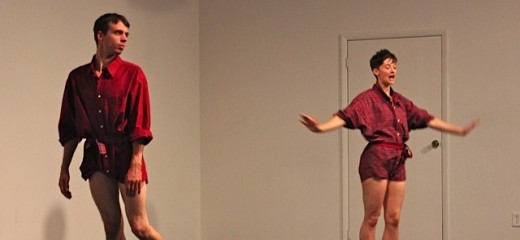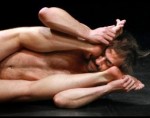
Photo: John Luna
Choreographing Curiosity: Smart Bodies Asking Smart Questions
by Annie Wilson
When I arrive at thefidget space, I hug the usher at the door (Sarah). I hug the ticket seller (Lisa). I hug several audience members, and meet new people. I hug the bartender (Alon). I hug the presenters of the show, Megan and Peter, whose loft we’re in. I have spent a lot of time here this year, rehearsing for two pieces. A marley dance floor stretches out at one end of the room, and behind the audience, a set of couches. Through one huge window I can see the rooftops of Kensington. A lone church spire stands halfway between here and the familiar Philadelphia skyline. If you get the sense that I’m about to watch a performance in a friend’s living room, it’s because I am.
Greg Holt and Sara Yassky, the two choreographers of the
You Sick Little Baby introduce themselves before the start of the show. The last time I saw Holt and Yassky’s work together was at a choreography workshop with
Susan Rethorst in 2010. Rethorst’s philosophy is that choreography is not illustrative of thought, it
is a form of thought. Tonight, the show opens with an image of Kylin Mettler and Kristel Baldoz mirroring one another – their feet pressed against the other’s, hands rooted in the ground, butts lifted in the air two inches, their focus like generous hot pokers into each other’s eyes. All of the decisions that went into this opening image reflect, rather than represent, the choreographer’s underlying value systems.
Holt and Yassky seem to be curious about mirroring, as it runs through all four pieces in the evening. In various moments the performers stand face-to-face, back-to-back, side-by-side. Each time they turn to face the audience, my sense grows a hair stronger that their bodies are reflecting an invisible, rarely regarded aspect of myself.
One moment in particular illustrates the mirroring laced through the show. At the beginning of “say no more!” I see Holt sit center stage with a small tape player, facing us. He presses play. I hear the sounds of “Loco Amor” drift thinly from the small speaker. He sits very still. His lip trembles. Something in his eyes shifts. My attention zooms in on these small transformations of facial expression. Is he focusing on stillness? Is he focusing on affect? He exhales, and turns off the tape player. He heaves once, twice, sucks in a huge helping of air, and gently smiling, turns the music back on. He doesn’t exhale. His lips tremble. I inhale. I exhale. I inhale, pause. His nostrils flare, pause. We exhale simultaneously.
Moments like these are embedded in the whole evening: the action is performed matter-of-factly; it is task-based. Humor emerges from the depths of the dance, like a blue whale. It surfaces, ripples across the audience in the form of laughter, and submerges again. I would love to describe the countless arresting moments such as these, in detail, accompanied by what I think it says about Yassky and Holt, and what it might say about me. If you want, we can grab a beer sometime and I’ll fill you in. But to me what is most important about the evening is not so much what each individual moment or piece reflects, but what the entire evening reflects.
A quote by
Nancy Stark-Smith comes to mind in regards to this kind of performance: “Replace ambition with curiosity.” While she’s referring to improvisation, it’s just as relevant to making and presenting dances such as these. What makes tonight as refreshing as a lager on a warm spring evening is the curiosity that sits in places where ambition normally exists. The evening carries both the informal vibe of a works-in-progress showing, without the apologetic tone that the pieces will get “better” in the future; and the rigorous, deep investigation of a fully produced evening of work without any vague pretentiousness (“This work will change the way you think about dance!”). The two makers ask questions: What would happen if we played an a capella U2 song, as I fling myself around my own kinesphere? What happens when a disembodied voice orders dancers to complete tasks in real time onstage? What does it mean to hold a distorted yoga pose for twenty seconds, resting before shifting to another? And another? And then returning to the original position, to repeat the sequence, over and over, with increasing speed, until the audience no longer sees each pose but instead sees continuous movement?
The casual, homey, atmosphere of thefidget space is an ideal location for this sort of performative inquiry. Yassky and Holt’s dances assert: You do not have to know what the choreographers are thinking in order to “get it.” You do not have to put down your own questions in order to engage with ours. Thefidget asserts: You do not have to leave your daily world in order to become curious about what you are seeing. Here, have a beer, take a seat. Our bodies have been asking these questions, what do you think?
And that is a rare find.
You Sick Little Baby, Sara Yassky and Greg Holt, the fidget space, May 18-19, 2012. No further performances.
By Annie Wilson
May 31, 2012










